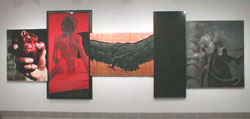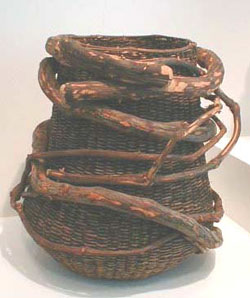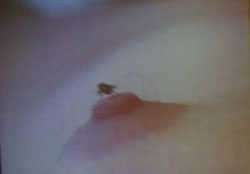As usual, I spent last Saturday looking at art. First, I went to the MFAH to see the Cos Cob Art Colony show, because my great-grandfather ran a boatyard there in the early part of this century. American impressionism is distinctly second rate, not so much technically as thematically. The picturesque quaintness Americans enjoyed (and still enjoy) in French impressionist paintings is laboriously re-created as kitsch. You can almost see artists searching the Connecticut waterfront for the ramshackle boathouse which most closely resembles a French barn.
I wandered through the scattered sections of the Broida collection. Apparently Broida was a victim of the 80’s art boom; the collection is filled with overblown but inconsequential pieces from false alarms like Longo and Clemente and lackluster production pieces like Bruce Nauman’s series of stone slabs inscribed with virtues and vices, and Claes Oldenburg’s oversized catcher’s mitt.
I headed for the always impressive Turrell tunnel (red this time), pausing in the lower hallway to look over the new accessions: a curious set of abstract woodcuts by Martin Puryear illustrating Jean Toomer‘s Cane, a book I haven”t read, but which, according to the tag, sparked the Harlem Renaissance. I always itch to read books in glass cases, but the MFAH’s library didn’t have a copy I could look at.
Next door to the library were baskets. The natural ones were best; bark and roots cleverly woven into beautiful baskets. Several pieces with more avant-garde pretensions succeeded in transcending great basketry to become bad art.
At the other end of the tunnel (all the action at the MFAH is in the tunnel these days) was the Robert Frank retrospective. Frank was a tourist, taking formally elegant, evocative snaps of Peru, Spain, Paris, and London before settling down to record his tourist’s view of American culture. His pictures of bikers, beauty queens, diners, and dustbowl farms give life to stereotypically American subjects, as if Frank searched the country for living examples of Hollywood archetypes. Frank’s most memorable photo is of his wife; Mary: Cape Cod. Sunlight and seawind give Mary a wild-woman desirability heightened by the photographer’s shadow cast possessively over half her face. Frank’s later photos descend into incoherent post-hippie rambling; collaged prints made from strips of film, superimposed images captioned with scrawled text, and grainy video stills shout disconnected fragments of Frank’s personal life without reaching any conclusions.
I didn’t mean to stop at Bernardo Bellotto and the Capitals of Europe, a huge show of dozens of finicky picture-postcard paintings of famous places and buildings, but it was the members” preview, and I’m a member (by marriage), AND they had free coffee and cookies, which I badly needed by this time. After the free food, you’ve got to at least peek at the show, or you”ll feel like a moocher. Bellotto used every tacky painting trick in the book, and I became fascinated with the rich vocabulary of slick gimmicks he used to simulate crumbling stonework, slate roofs, and fluffy trees, cranking out painting after painting, almost without variation. Munich, Venice, Vienna, etc. — have brush, will travel.
Punchy, I walked over to the CAM to see Yes: Yoko Ono. If you don’t see anything else in this encyclopedic show, watch FLY. Hilarious and disturbing, disgusting and titillating, silly and serious, this short film is one of Ono’s best. A nude woman (played by Virginia Lust) lies splayed out on a mattress, motionless, as big flies crawl all over her body. It’s excruciating. And then there’s the sound track: Yoko screeching and wailing like a greedy fly herself, or a tortured model holding still as big flies crawl all over her body. It’s excruciating. Watch it.
All images courtesy the artists and museums.
Bill Davenport is an artist and writer and was one of the first contributors to Glasstire.







